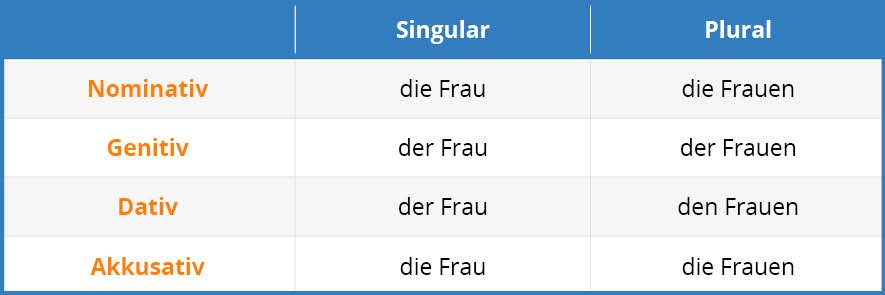German Nouns
Nomen im Deutschen – Erklärungen und Beispiele
German Nouns – Summary
Zusammenfassug
Nouns are words which represent people, animals and things (tree, cat, house) and even abstract things (like time, force or quantity).
There are words that are often put in front of nouns:
- The articles, like “der Baum”, “die Katze” or “das Haus”.
- The adjectives, like “der große Mann” or “die schöne Frau”.
- The possessive pronouns, like “seine Hose” or “ihr Kleid”.
- And, of course, other words, like those indicating quantity: “Kein Mensch”, “einige Menschen”, “viele Menschen”, “alle Menschen”.
Nouns are characterized by three attributes:
- Their gender:
der Baum (masculine)
die Katze (feminine)
das Haus (neutral) - Their number:
der Baum (singular)
die Bäume (plural) - Their case:


Nouns are a fundamental element of German grammar, just like in every other language. Different from the English language, German nouns have grammatical gender. So, they can be divided into three kinds:
- masculine gender
- feminine gender
- neuter gender
But we wouldn’t talk about German grammar if there wasn’t a lot more difficult than just that. On the one hand, German nouns change their forms depending on their grammatical case, on the other hand, they change whether they are singular or plural.
Before we come to a more detailed explanation of German nouns, there are some important facts about them:
German nouns are, as a rare exception among the different languages on this planet, always capitalized. That means: They are written with an initial capital letter.
In many cases, German nouns are so-called compound nouns. So, they consist of two or more smaller nouns stuck together.
Well, articles in German always come together with their nouns. To get a better idea of that, just have a look at our text about German articles! As we cleared up some basics, let’s now go to some details about German nouns!
Declension, Singular and Plural
Deklination, Singular und Plural
So, as already mentioned above, German nouns vary in their form depending on their grammatical case. Of course, you already know the different cases in German. We’ve got nominative, genitive, dative, and accusative.
It is a bit confusing when you compare it to English, where almost no cases exist for nouns, except for genitive. Nevertheless, it is no big deal getting into German cases and the connected German nouns, if you put some effort into it!
Well, let’s start right ahead with some tables that show us how the German noun “der Mann” (the man), “die Frau” (the woman), and “das Bild” (the picture) vary. As you can easily see looking at the masculine, feminine and neuter article “der”, “die”, and “das”, we have masculine, feminine and neuter nouns. Of course, these are the singular articles, the plural article differs, and you will also find the different plural forms in the right column.
CONJUGATION OF „DER MANN“:

CONJUGATION OF „DIE FRAU“:

CONJUGATION OF „DAS BILD“:

Of course, it might seem to you that the gender of a noun varies completely randomly. But here are some good news: Luckily, there are certain rules that determine whether a noun is masculine, feminine or neuter. Of course, there are exceptions, as you can find them in every language – don’t care too much and take a look at the following guidelines.
Words ending in -or, -ling, -smus, or -ig are nearly always masculine.
Examples: der Rotor (the rotor), der Liebling (the favorite), der Egoismus (the egotism), der Honig (the honey)
Words ending in -ung, -keit, -schaft, –tät, -ik, -tion, -heit, or -ei are feminine.
Examples: die Beleidigung (the insult), die Beständigkeit (the stability), die Kundschaft (the clientele), die Banalität (the banality), die Romantik (the romance), die Deklination (the declension), die Schönheit (the beauty) and die Schreinerei (the carpentry)
Words ending in -chen, -ma, -um, -ment, -lein, or -tum are neuter.
Examples: das Mädchen (the girl), das Enigma (the enigma), das Judentum (the judaism), das Firmament (the firmament)
And here you have some general tricks and rules for declension:
- In case you have given the nominative singular, genitive singular, and nominative plural of a noun, it should be no problem for you to determine its declension.
- Mostly, all singular forms for feminine nouns are the same!
- In a great number of cases, German nouns in their dative and accusative forms do not take declension.
Compound Nouns
Zusammengesetzte Nomen
Finally, we reached a rather funny part of German nouns – the compound nouns! German compound nouns can actually consist of an unlimited number of nouns or roots. Due to this fact, surrealistically-long nouns can be created. Here are some examples to be found in Wikipedia:
“Rinderkennzeichnungs- und Rindfleischetikettierungsüberwachungsaufgabenübertragungsgesetz”
– which basically means “Cattle Marking and Beef Labelling Supervision Duties Delegation Law”, i.e. the name of a law established in the state of Mecklenburg-Vorpommern in the year 1999.Another, though really well-known, compound noun is:
Donaudampfschifffahrtsgesellschaft, which means “Danube Steamboat Shipping Company”. That’s a company that really existed in the year 1829.
Well, some explanation of compound nouns:
Compared to the English language, German compound nouns are always written in one single word. In addition, we have a grammatical phenomenon: the so-called “Fugen-s”, which comes in between the nouns.
Here, many compound nouns develop an “s” between their actual stem nouns, although there should not be one originally. Sometimes, it’s their genitive “s”, but in many cases, the “Fugen-s” develops in German nouns that don’t have a genitive “s”. Of course, the “Fugen-s” in German nouns is not always necessary, nevertheless, there are many words that do not work without it. Here are some examples (taken from here):
- Hochzeitskleid – wedding dress
- Liebeslied – love song
- Abfahrtszeit – time of departure
- Arbeitsamt – employment agency
Exercises
Übungen
Finally, we have reached the last part of this article where you can prove the German skills you have just learned. In the following, you will see some phrases that you should complete with the correct terms. Once you have filled all the gaps, just click on the “correct” button and you can see your errors and the correct results. Good luck and … auf Wiedersehen!


